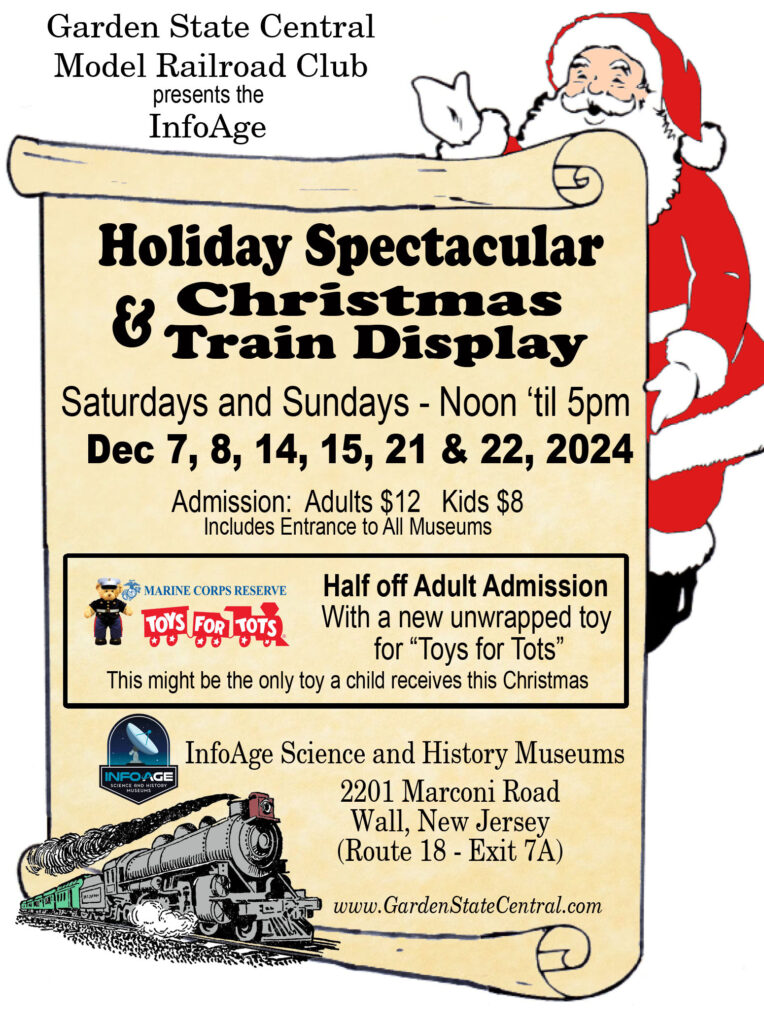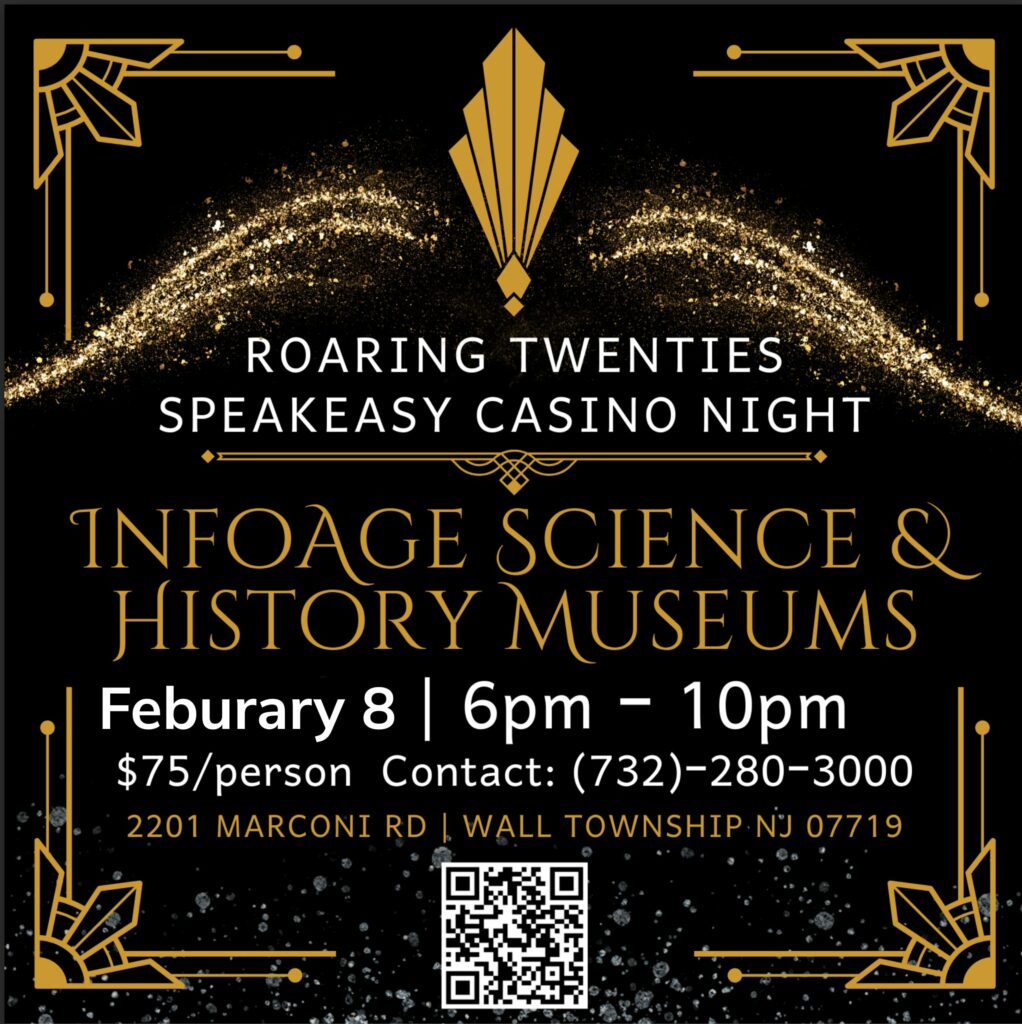The Naval Period
U.S. Gives Radar Secrets, ‘Major Reason’ of VictoryU.S. Gives Radar Secrets, ‘Major Reason’ of Victory
The New York Daily News
August 15, 1945
This story was printed the day World War Two ended. It is an excellent overview of the major roll radar played in the Allied victory. It also predicts the future of electronics. As the Signal Corps radar laboratory Camp Evans played a fundamental roll in the “story of victory in a laboratory race against the enemy”. Camp Evans contracted, funded and coordinated radar research by famous laboratories at Bell Labs, Harvard, and MIT.
The story features two photos directly related to Camp Evans. The photo captioned: “Radar equipment at Camp Evans, Belmar, NJ” is an SCR-268 radar. Camp Evans was the WWII home of the SCR-268, 270, and 271 plus the production engineering site of the British cavity magnetron based SCR-584, protyped by MIT. The second photo captioned: “Dr. A. Hoyt Taylor and Leo Young, two of the pioneers in the field of radar” relates to Camp Evans also. During WWI when Camp Evans was the U.S. Naval Radio Station at Belmar. Dr. Taylor was the Trans-Atlantic Communications Officier in charge of the Belmar station. The Belmar station acted as the central communications point in direct contact with Washington. Mr. Young broke his arm while he was at the old Marconi station attempting to start a hand-cranked auto to find the source of suspected spy transmissions to German submarines off the Jersey Shore during WWI. Louis A. Gebhard was also part of the Belmar team. Dr. Taylor became the father of naval radar at the Naval Research Laboratory.
Camp Evans is not only the WWII home of Army radar, it has connections with the developers of naval radar who were station at the site in WWI. After the war, under Project Paperclip, selected German radar scientists would be brought to Camp Evans.
Thanks to Mr. Larry Wilkins of OMARC for this great Daily News article.
Mr. Mike Blom sent us an unpublished Acme photo of another view of the SCR-268 in the story below taken by the press to prepare for this story.
By Reuel S. Moore
Washington, D. C., Aug. 14 (U.P). – The Army and Navy tonight unfolded the long-secret story of radar, second only to the atomic bomb as the war’s most revolutionary scientific development, the margin of victory in the Allies’ darkest hours and a springboard to the perfection of television and other far-reaching changes in postwar living.
Radar is an amazing “seeing eye” electronic device capable of cutting through the blackest night and the thickest fog unerringly. It enables fighting men to track down, chart and destroy a target they never see.
Obscured by the atomic bomb in sensationalism, radar possibly has been more valuable because it was at work for the Allies when they might have lost the war without it. It turned the tide in the Battle of Britain, helped win the long struggle against German submarines, made possible the precision blasting of the German industry, and helped U.S. ships and planes drive the Jap navy from the seas.
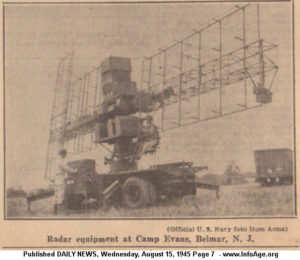 Radar equipment at Camp Evans, Belmar, N.J.
Radar equipment at Camp Evans, Belmar, N.J.
*** We hope to find an original photo to scan and post***
Laboratory Victory.
Like the atomic bomb, the story of American and British radar is the story of victory in a laboratory race against the enemy. Both Germany and Japan used it, but they never caught up with the Allies. As one Army spokesman put it:
“In the technical field, where so much of this war has been fought, the failure of the Nazis and the Japs to keep pace with Allied radar has been probably the major single reason for defeat.”
In peacetime, radar is expected to make air and sea navigation foolproof, regardless of night or weather. Its immediate use inland transport is less sure. In its present form, it is not very useful on automobiles or locomotives.
A joint scientific board of the Army, Navy and the Office of Scientific Research and Development said its greatest benefit will be its effect upon the electronics industry.
“Radar has made the electronics industry one of America’s major ones, now comparable in size to the prewar automobile industry,” the board said. “This new industry can be expected to find innumerable applications in a wide variety of fields.”
Television Around Corner.
“If television is still around the corner after the war, economic factors, not technical ones, will have kept it here. Communications, especially radio, will have a tremendous flowering.
“Altogether, it is fair to say that radar, as radar, will have a mild immediate beneficial effect on all our lives. But the impact on electronics generally of techniques developed during the war because of radar will have profound and far-reaching effects on the shape of our daily life.”
Radar’s name is coined from the words which tell its function – radio detection and ranging. Here is a typical picture of how it works in naval warfare:
An enemy fleet approaches, radar detects its size and direction. An open fire is ordered. An observer watches a screen bearing a panoramic replica of the entire area. He watches the shells move across the screen. The salvo appears to land squarely on the leading ship. Its replica fades slowly from the screen. The vessel was discovered, identified, tracked down, fired upon and sunk without a man seeing it visually.
How It Works.
Here, in principle, is the way radar works:
Unlike other communications, the transmitter and receiver are at the same place. The transmitter sends out intense bursts of energy called pulses. They may be only one-millionth of a second in duration. During the interval between pulses, the receiver is receiving “echoes” which a pulse produces when it contacts a nearby object. Echoes from the nearest objects form soon after the pulse is sent. Those farther away give later returns. The interval between the transmissions of the pulse and the reception of its echo measures the distance of the object – ship, plane, mountain, or building.
The direction of the target is determined by a rotating antenna that sends out pulses in a narrow beam, like a searchlight. When the antenna is pointed toward the target, a “pip,” or direction indicator, is flashed back. The strongest pip is returned when the antenna is beamed directly at the target. The bearing of the antenna then is used to point a gun, to set the course if a bomber, to direct a fighter plane, or for innumerable other uses.
IFF Tells Foes.
The reflected radio pulses are recorded on a “scope,” a cathode ray screen similar to that used in television. One of the most ingenious of the scopes is the PPI – “plan position indicator.” The antenna rotates in a full circle. A luminous line moves around the scope, like the hand of a clock. It leaves a map-like reproduction of the surrounding area.
Another device is IFF – “identification of friend or foe.” It sends out a signal which brings an automatic coded response, identifying friendly craft. Still another set automatically warns a fighter pilot when another plane is approaching.
On a radar screen, water reflections are black. Flat solid surfaces, ships, and buildings show up white. Landmasses vary from gray to white. The resultant image is not unlike a black and white halftone reproduction of a relief map. All waterways, shorelines, and bridges are clearly defined.
The idea of using radio pulses for detection occurred simultaneously in the United States, Britain, France, Germany, and possibly Japan. Preliminary work began in this country in 1922. Congress appropriated $100,000 for naval research in 1935, and a year later the Army perfected a set to detect aircraft. The first shipboard radar was operated from the destroyer Leary in 1937. Two years later, the Army had long-range detector equipment that could record the approach of a bomber 100 miles away.
After 1940, research and development were carried on cooperatively by the United States and Britain.
Production in this country was given top priority and a new industry was born. Non-existent in 1940, radar factories by July 1 of this year had delivered $2,700,000,000 of equipment to the Army and Navy.
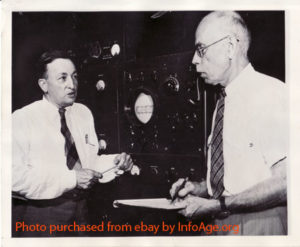
Dr. A. Hoyt Taylor (left) and Leo Young, two of the pioneers in the field of radar. (Official U.S. Navy foto from Acme)
Scientific Pioneers.
“The scientific pioneering, engineering skills and plain hard work that these figures represent has been paid for over and over by the accomplishments of radar in giving new eyes to our forces on land, in the sea and air,” the joint board said.
Radar permitted Allied fliers to track down and destroy German submarines by the hundreds at a time when the U-boat campaign was threatening to choke off supplies and equipment for beleaguered Britain. Later, it was used to pin-point targets in daylight precision bombing despite the most unfavorable weather. And last summer, when German V-bombs were pounding Britain, it led Allied fliers to the launching sites.
Radar showed its work in naval warfare back in 1942 when the battle for Guadalcanal still was undecided. With its aid, the cruiser Boise sank three Jap cruisers and three destroyers in 27 minutes.
In the same campaign, the famous cruiser San Francisco sailed into the midst of an entire Jap fleet, its guns blazing. The Japs fired at each other in confusion. The entire enemy fleet was sunk.
Among the U.S. scientists responsible for its development are Dr. A. Hoyt Taylor, chief consultant of electronics at the naval research laboratory; Leo C. Young, his associate since 1922; Dr. Gregory Breit and Dr. Merle A. Tuve of Carnegie Institute, Louis A. Gebhard and Matthew H. Schrenk of the Navy laboratory; Dr. Roger M. Page, formerly of Hamline University, and Robert C. Guthrie of the University of Montana.
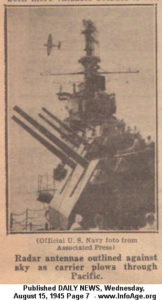
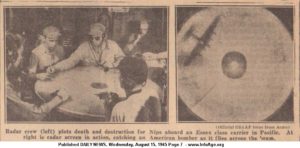
page created July 26, 2002
We Need Your Help! Volunteer with Us.
Join our mission to preserve historic Camp Evans and teach the public about science and history.
Sign up to join our team of volunteers and start on your own mission today.
InfoAge Science & History Museums
2201 Marconi Road
Wall, NJ 07719
Tel: 732-280-3000
info@infoage.org
webmaster@infoage.org
